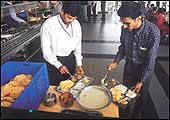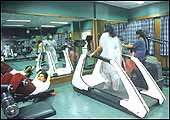








|
MANAGING
All In A Day's Work
As the head of HR at India's best
employer, Hema Ravichandar receives more than 1,000 job applications every
day. Here's how she picks, manages and retains the best of software
talent.
By Venkatesha
Babu
 |
| Hema
Ravichandar: Infosys' HR ace at her corner-office on the sprawling
campus |
It's half
past seven in the morning, and Hema Ravichandar is in the back of her
Maruti Zen, laptop spread open, headed for work. Over the next 40 minutes
that it takes to reach Infosys City from her house at Langford Town in
Bangalore, Ravichandar will answer approximately 18 e-mails from people
including external consultants, and Nandan Nilekani, the company's
Managing Director, coo and President. In between, the mobile rings, and
Ravichandar answers the call to confirm an appointment later in the day.
Hanging up, she calls a colleague to cross-check a few numbers. There will
be more e-mails and meetings to attend once she reaches Infosys' 50-acre
campus.
If the 40-year-old's typical day at work
seems inordinately busy, there's good reason for it. As the Senior Vice
President of Human Resources at India's best employer (see BT, January 21,
2001), Infosys, Ravichandar leads a global team responsible for
organisational effectiveness initiatives, learning and development,
compensation and benefits, and recruitment, among others. All that means
managing the software giant's workforce of 10,554 spread over 19 offices
worldwide.
 |
| TIME TO
PLAY: Fine, they don't let you wear shoes on the greens, but how
many companies can boast of a 9-hole golf course? |
 |
| TIME TO EAT:
What will it be for lunch? Pizza, biryani, or sambar vada?
At Infosys, you can always pick and choose. |
 |
| TIME TO WORK
OUT: All the code-writing getting to you? Take a break, pump some
iron, or just work the treadmill. |
The staggering numbers
But what makes her job truly unique is the
sheer number of job applications that Infosys receives. Last year, the
count stood at a staggering 3,85,248-that's more than 1,055 resumes a day.
If opening and reading each one of these resumes took just five minutes,
Infosys would need 11 dedicated people doing a non-stop eight-hour shift
to clear the pile before they go home. Obviously, that's not how the
company works. So, just what are the systems that allow Ravichandar and
her team to sift through this mountain-load of resumes and pick the best
software talent?
Here's what happens to any resume that lands
up at Infosys: Irrespective of the format in which an application is sent,
it is converted into a standard format by a software the company has
adopted. Then, an initial screening of the academic qualifications of the
candidate is done. The software awards grades to applicants depending on
their alma mater and qualification. For example, a B.Tech from IIT gets
more points than a be from a regional engineering college.
Once stored in the company's database, all
resumes are available to hiring managers. A manager only has to key in his
or her requirements and 'profiles' of available candidates get generated.
The manager further narrows down the choice and the hr team is intimated.
The shortlisted candidates are called for a written test and interviews.
Huh? These are big knock-out rounds. For
example, here's how a sample question from the written test would look
like: If a plane has no singularities except nine cusps, how many double
tangent will it have?
After three rounds of tests and interviews,
less than two in 1,000 candidates will make it. Last year, for instance,
Infosys recruited a bare 4,500 from the 3,85,248 applications it received.
Once the software engineer comes on board, he
or she is put through 8-12 weeks of intensive training according to an
'education roadmap'. The focus is on both specific skills and general
concepts. Infosys also has an education and research group responsible for
training of its engineers. Every year employees are made to undergo two
weeks of training in their area of technical specialisation. The annual
spend on training? Five per cent of the topline.
These days Ravichandar is focusing more on
lateral hires than campus recruitments. (Lateral hire is hr-speak for
hiring somebody with considerable work experience.) The advantage of doing
so, she explains, is that the company readily gets a specific set of
skills that it wants. Today, there are plenty of good software engineers
either on the bench or at loose ends. But, as Ravichandar points out,
''recruiting and retaining top-flight talent is always a difficult task,
even during a tough environment. The best guys in the business are always
in demand, recession or no recession. Besides, the war for talent is not
limited by geography anymore.''
It is probably a measure of Infosys'
reputation then that despite its industry-average salaries, software
engineers make a beeline to it. The company's generous ESOPs are, of
course, a big draw. But that's not the only way by which Infosys takes
care of its people. For example, its new campus has a 5,000-sq ft
gymnasium with a sauna. There's a golf course, and a food court serving
pizzas and a variety of Indian food. And almost all the senior executives
keep an open office. Given all that, if there's anybody who loves working
for Infosys, it must be the local postman.
|

